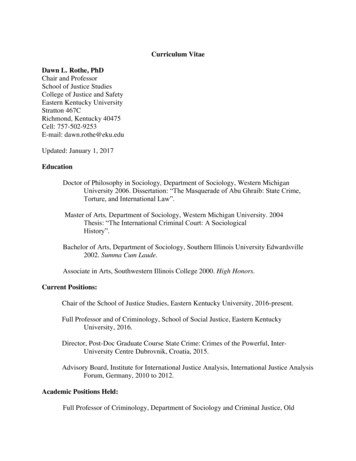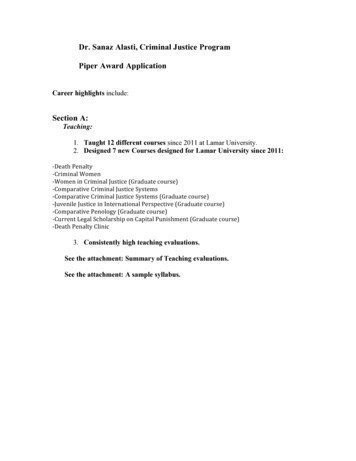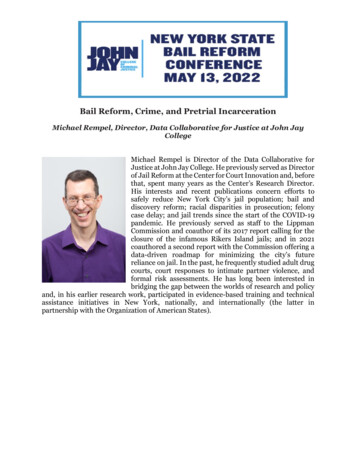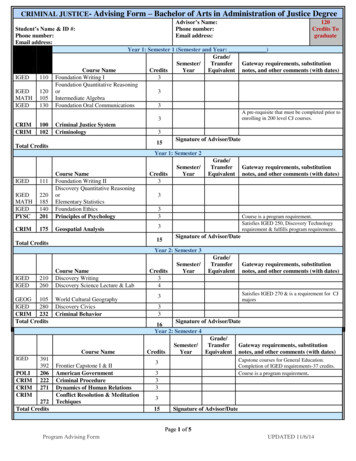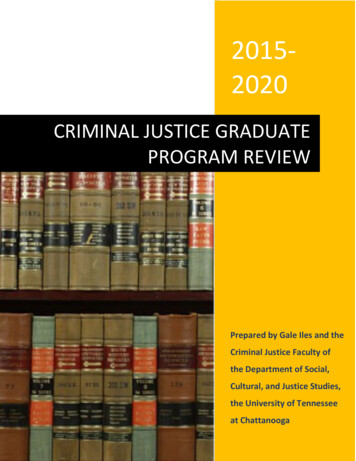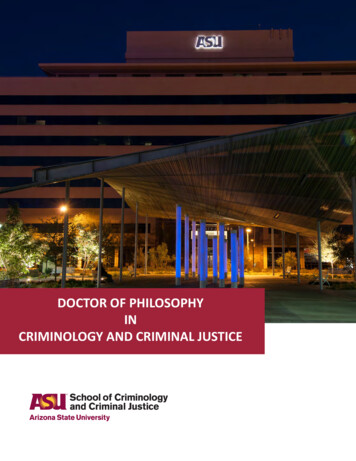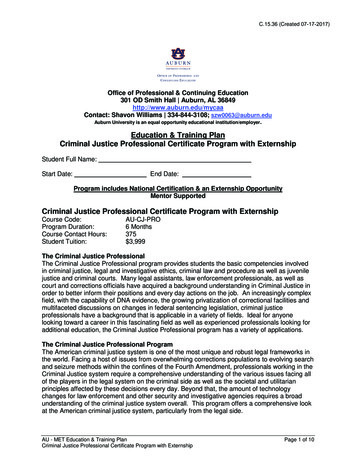
Transcription
C.15.36 (Created 07-17-2017)OHICE OF P ROFESSIONAL ANDCONTINUING EDUCAT I ONOffice of Professional & Continuing Education301 OD Smith Hall Auburn, AL 36849http://www.auburn.edu/mycaaContact: Shavon Williams 334-844-3108; szw0063@auburn.eduAuburn University is an equal opportunity educational institution/employer.Education & Training PlanCriminal Justice Professional Certificate Program with ExternshipStudent Full Name:Start Date:End Date:Program includes National Certification & an Externship OpportunityMentor SupportedCriminal Justice Professional Certificate Program with ExternshipCourse Code:Program Duration:Course Contact Hours:Student Tuition:AU-CJ-PRO6 Months375 3,999The Criminal Justice ProfessionalThe Criminal Justice Professional program provides students the basic competencies involvedin criminal justice, legal and investigative ethics, criminal law and procedure as well as juvenilejustice and criminal courts. Many legal assistants, law enforcement professionals, as well ascourt and corrections officials have acquired a background understanding in Criminal Justice inorder to better inform their positions and every day actions on the job. An increasingly complexfield, with the capability of DNA evidence, the growing privatization of correctional facilities andmultifaceted discussions on changes in federal sentencing legislation, criminal justiceprofessionals have a background that is applicable in a variety of fields. Ideal for anyonelooking toward a career in this fascinating field as well as experienced professionals looking foradditional education, the Criminal Justice Professional program has a variety of applications.The Criminal Justice Professional ProgramThe American criminal justice system is one of the most unique and robust legal frameworks inthe world. Facing a host of issues from overwhelming corrections populations to evolving searchand seizure methods within the confines of the Fourth Amendment, professionals working in theCriminal Justice system require a comprehensive understanding of the various issues facing allof the players in the legal system on the criminal side as well as the societal and utilitarianprinciples affected by these decisions every day. Beyond that, the amount of technologychanges for law enforcement and other security and investigative agencies requires a broadunderstanding of the criminal justice system overall. This program offers a comprehensive lookat the American criminal justice system, particularly from the legal side.AU - MET Education & Training PlanCriminal Justice Professional Certificate Program with ExternshipPage 1 of 10
C36 (Created 09/03/15)Education and National Certifications Students should have or be pursuing a high school diploma or GED. There are no state approval and/or state requirements associated with this program. There is a National Certification exam available to students who successfully completethis program: Microsoft Office Specialist (MOS) Certification Exam.Program ObjectivesAt the conclusion of this program, students will be able to: Define key terms related to the justice system and examine the justice system Analyze concepts related to criminal law and compare and contrast theories of crime Evaluate the impact history has had on the American justice system Examine issues and emerging trends in criminal justice Define terms, purpose and function of criminal law Assess legal issues as presented in court cases and key concepts of criminal law Define key concepts related to ethics Explain the impact of ethical decisions Explain the relationship between values, morals, ethics, and critical thinking Compare and contrast philosophies related to ethics Analyze the process of making ethical decisions Examine ethics in the criminal justice system Evaluate methods used to address ethical misconduct in society Use Microsoft OfficeNational CertificationUpon successful completion of this Auburn University program, students would be eligible to sitfor the Microsoft Office Specialist (MOS) exam. Although there are no state approval, stateregistration or other state requirements for this program, students who complete this program atAuburn University will be prepared and are eligible to sit for this national certificationexam. Students who complete this program are encouraged to complete the externship optionwith their program. Students who complete this program can and do sit for the MOS nationalcertification exams and are qualified, eligible and prepared to do so. Auburn University workswith each student to complete the exam application and register the student to take theirnational certification exam.Externship / Hands on Training / PracticumAlthough not a requirement, once students complete the program, they have the ability toparticipate in an externship and/or hands on practicum so as to practice the skills necessary toperform the job requirements of a professional in this field. Students will be assisted withcompleting a resume and/or other requirements necessary to work in this field. All students whocomplete this program are eligible to participate in an externship and will be placed with aparticipating organization near their location. Auburn University works with nationalorganizations and has the ability to place students in externship opportunities nationwide.Auburn University contact: If students have any questions regarding this program includingnational certification and externships, they should call Shavon Williams of AuburnUniversity at 334-844-3108 or via email at szw0063@auburn.eduNote: No refunds can be issued after the start date published in your Financial Award document.AU - MET Education & Training PlanCriminal Justice Professional Certificate Program with ExternshipPage 2 of 10
C36 (Created 09/03/15)About Auburn University!Welcome to Auburn University! Auburn University was established in 1856 as the EastAlabama Male College, 20 years after the city of Auburn's founding.OUR MISSION: The Office of Professional and Continuing Education (OPCE) makes theeducational resources of Auburn University available for non-credit education programs andconferences designed to promote lifelong learning, regardless of age, interest, or location. Ourprograms fall into five general categories: Professional Development, Certificate Programs,Personal Enrichment, Summer Youth Programs, and burn University and Pearson EducationThe Auburn University’s Office of Professional and Continuing Education eLearning programswere developed in partnership with Pearson Education to produce the highest quality, best-in class content and delivery necessary to enhance the overall student learning experience, boostunderstanding and ensure retention. Pearson Education is the premier content and learningcompany in North America offering solutions to the higher education and career trainingdivisions of colleges and universities across the country aimed at driving quality educationprograms to ensure student success. Please visit us at www.pearson.com.About Pearson EducationWelcome to Pearson. We have a simple mission: to help people make more of their livesthrough learning. We are the world's leading learning company, with 40,000 employees in morethan 80 countries helping people of all ages to make measurable progress in their lives. Weprovide a range of education products and services to institutions, governments and direct toindividual learners, that help people everywhere aim higher and fulfil their true potential. Ourcommitment to them requires a holistic approach to education. It begins by using research tounderstand what sort of learning works best, it continues by bringing together people andorganizations to develop ideas, and it comes back round by measuring the outcomes of ourproducts.AU - MET Education & Training PlanCriminal Justice Professional Certificate Program with ExternshipPage 3 of 10
C36 (Created 09/03/15)Criminal Justice Professional Program Detailed Student Objectives:CRIMINAL JUSTICE Define key terms related to the justice system Discuss the role of the justice system in responding to crime Explain the criminal justice process Examine the various levels of government that are a part of the justice system Analyze goals of the justice systemCATEGORIES, MEASUREMENT, AND THEORIES OF CRIME Define categories of crime Describe how crimes are measured Identify problems with measuring crime Compare and contrast theories of crimeCRIMINAL LAW Define types of crime Identify sources and types of law Examine elements that must be present for a crime to be said to have occurred Describe features of crime Examine arguments used in defending against a criminal indictment Discuss the impact of previous systems of laws on how our laws are currently structuredBASICS OF LAW ENFORCEMENT Define terms associated with law enforcement Describe levels of law enforcement Examine the justice system Examine innovations in policing Discuss expectations of law enforcement Describe policing styles Examine police subculture Evaluate past and current functions of law enforcement Examine the impact that history has had on the present system of law enforcement Examine issues of gender and race as related to law enforcementLEGAL ISSUES AND CHALLENGES FOR LAW ENFORCEMENT Define key terms related to policing Describe the different types of force that can be used by police Identify challenges to traditional policing Discuss symptoms of and solutions to police stress and burnout Examine the Fourth Amendment Describe various procedural lawsORGANIZATION OF COURTS Define key terms related to the court system Trace the history of the courts Describe the development of the jury Chart the organization of the courts Define the roles of members present in a courtroomADJUDICATION Define key terms related to the justice system Define key terms related to corrections and capital punishment Differentiate among the types of plea bargaining arrangementsAU - MET Education & Training PlanCriminal Justice Professional Certificate Program with ExternshipPage 4 of 10
C36 (Created 09/03/15) Describe the steps in the trial processExamine rights afforded to defendants in a criminal trialDescribe the types of sentences that a defendant can receiveDescribe capital punishmentCompare and contrast the pros and cons of capital punishmentIdentify issues that arise in most courtsHISTORY OF CORRECTIONS Define key terms related to the courts and the prison system Map the history of control before prisons Map the history of prisons in America Examine the impact that history has had on the present prison system in the UnitedStates Explain how prisons have evolved Explain the differences between prisons and jail Compare private and public prisonsPRISON LIFE AND ALTERNATIVE SANCTIONS Define key terms related to the courts and the prison system Describe the relationship between courts and prisons Discuss various elements of prison life and the subcultures that exist within prisons Identify the goals of the criminal justice system Examine alternative programs established for offendersJUVENILES IN THE JUSTICE SYSTEM Define key terms related to the juvenile justice system Map the historical treatment of children and the juvenile justice system in the UnitedStates Explain the differences between adult and juvenile justice systems Examine the impact that history has had on the American juvenile justice system Examine current issues in the juvenile justice systemDRUGS AND THE CRIMINAL JUSTICE SYSTEM Define drug abuse and other crimes Discuss how illegal drug use is being addressed in the United States Map the history of drug use and drug laws in the United States Evaluate the effectiveness of programs to address illegal drug use in the United StatesPURPOSE AND SOURCES OF CRIMINAL LAW Define types of crime Define types of law Discuss the purpose of law Compare and contrast the differences between criminal law and other forms of law Describe the U.S. federal system of laws (the U.S. Code) Examine the efforts made in the U.S. to standardize American criminal law betweenjurisdictions Define stare decisis Debate the notion that stare decisis is an inexorable commandCRIMINAL LIABILITY Define terms related to criminal liability and the elements of crime Define corpus delicti Describe the adversarial system Discuss elements of crimeAU - MET Education & Training PlanCriminal Justice Professional Certificate Program with ExternshipPage 5 of 10
C36 (Created 09/03/15) Describe how negligence can occurEvaluate whether simple negligence can provide the basis for criminal liabilityDetermine what constitutes the corpus delicti of an offenseEXTENDING CRIMINAL LIABILITY Define terms related to criminal liability Define inchoate crimes Identify elements of the crime of attempt Compare conspiracy and criminal solicitation Explain the common law categories used to describe parties to a crime Examine what constitutes a "substantial step" toward commission of a target offense Describe when a private corporation can be held liable for the crime of homicideDEFENSES Define terms related to criminal defenses Describe the nature of defenses Illustrate categories of justifications and excuses as defenses Examine when deadly force can be used as a claim of self-defense Debate the use of the "battered woman's" defense Analyze what constitutes entrapment by government agentsINSANITY Define insanity Map the history of the insanity defense Explain how competency to stand trial is assessed today Examine insanity as a defensePERSONAL CRIME: HOMICIDE Define death as a legal term Identify types of criminal homicide Classify categories of murder and manslaughter Examine statutes regarding the crime of aiding in a suicide Analyze the differences between murder and involuntary manslaughterPERSONAL CRIME: ASSAULT, BATTERY, AND OTHER PERSONAL CRIMES Define terms related to types of personal crime Discuss different types of assault Differentiate between assault, battery, and aggravated battery Identify laws designed to protect individuals from personal crimes Debate what constitutes the crime of stalkingPROPERTY AND COMPUTER CRIMES Define theft Identify wrongful acquisition crimes Summarize the definitions and principles of crimes of theft Describe elements and types of burglary Identify types of computer crime Discuss computer crime laws and enforcement agencies Analyze what constitutes the crime of computer tamperingCRIMES AGAINST PUBLIC ORDER AND THE GOVERNMENT Define public order offenses Identify three categories of social order crimes Discuss different public order offensesAU - MET Education & Training PlanCriminal Justice Professional Certificate Program with ExternshipPage 6 of 10
C36 (Created 09/03/15) Identify categories of crimes against the administration of governmentSummarize crimes against the administration of governmentDebate issues related to public conduct and the lawCRIMES AGAINST PUBLIC DECENCY AND MORALITY Define victimless crimes Identify categories of crimes against public decency and morality Discuss crimes against public decency and morality Analyze laws that regulate public decency and morality Determine when laws related to the transfer of computer-generated information havebeen violatedVICTIMS AND THE LAW Define terms related to criminal law and victim's rights Define the word victim Explain how criminal victimization is measured in the United States Map the history of laws that have addressed the needs of victims Debate the constitutionality of notoriety-for-profit lawsPUNISHMENT AND SENTENCING Define terms related to criminal punishment and sentencing Explain primary sentencing rationales Illustrate ways to impose criminal sanctions Debate the issue of capital punishment Summarize hate crime laws Examine factors that a jury might consider in determining if the death penalty is anappropriate sentenceRECOGNIZING ETHICAL DECISIONS Define morality Define critical thinking Recognize values Recognize ethical decisions Explain the origins of moral rules Explain how ethical decisions affect others Summarize how critical thinking is related to ethics Differentiate between morals and ethicsVIRTUE ETHICS Define virtue Define moral virtue Explain the history of virtue ethics Describe the Socratic Method of teaching Identify the hierarchy of goods Explain the philosophy of Stoicism Differentiate between stoicism and hedonism Interpret Aristotle's views of moral virtue Explain approaches to evaluating ethical dilemmasFORMALISM Define deontological ethics Define categorical imperative Define practical imperative Explain Kantian ethicsAU - MET Education & Training PlanCriminal Justice Professional Certificate Program with ExternshipPage 7 of 10
C36 (Created 09/03/15) Discuss how the philosophy of categorical imperative is thought to guide all conductIdentify the strengths and weaknesses of Kant's philosophy regarding ethicsDistinguish between virtue ethics and formalismUTILITARIANISM Define terms related to utilitarianism Explain the central principle of utility Paraphrase John Mill's ethical perspective as related to pain and pleasure Illustrate the differences between motivation and consequences Explain utilitarianism Articulate criticisms of utilitarianismCRIME AND LAW Define virtue ethics Discuss the consensus view and conflict view of criminal law Differentiate between what is illegal and what is immoral Examine the four major approaches to explaining criminal behaviorETHICAL THEORIES, CRIME, AND LAW Define virtue ethics Define formalism Define utilitarianism Differentiate between virtue ethics, formalism, and utilitarianism in terms of similaritiesand differences Examine how laws reinforce existing moral beliefs of citizensPOLICE: HOW SHOULD LAW BE ENFORCED? Define terms related to law enforcement and ethics Identify the three forms of police corruption Describe the ethical challenges facing police when performing investigations andsurveillance Discuss ethics in relation to procedural law Identify where ethics influences police corruption Explain the Miranda warning and how it relates to ethics Examine the ethics of lying in courtCOURTS: HOW OUGHT A CASE BE ADJUDICATED Define two kinds of judicial decisions Describe the role of the defense attorney and prosecutor Explain what constitutes ethical behavior of the prosecution and the defense Discuss ethical issues within a trial Analyze the moral responsibility that attorneys have to protect othersPUNISHMENT AND CORRECTIONS Define key concepts related to the ethics of punishment Identify ethical problems within sentencing Restate ethics of corporal punishment Discuss the ethics of innovative penalties Express ethical issues involved with capital punishmentLIABILITY Define key concepts related to the consequences of unethical conduct Describe ways to test individual ethical conduct Identify civil remedies for ethical misconductAU - MET Education & Training PlanCriminal Justice Professional Certificate Program with ExternshipPage 8 of 10
C36 (Created 09/03/15) Debate ethical versus unethical behavior in corporations and governmentAnalyze ethical dilemmas and determine the consequencesTHE FUTURE: MORE OR LESS ETHICAL Define "scarcity mentality" Identify ethical decisions Explain how ethical decisions affect others Examine the moral permissibility of a course of action Apply ethical principles to a moral decisionBEING ETHICAL WHEN NO ONE IS LOOKING Define ethical behavior Identify the frequency of making ethical decisions in everyday life Develop a code of ethics to assist one in making ethical decisions Examine the moral permissibility of an ethical decisionNote: This program can be completed in 6 months. However, students will have online access tothis program for a 24-month period.MICROSOFT OFFICE Module Use an integrated software package, specifically the applications included in theMicrosoft Office suiteDemonstrate marketable skills for enhanced employment opportunitiesDescribe proper computer techniques for designing and producing various types ofdocumentsDemonstrate the common commands & techniques used in Windows desktopList the meaning of basic PC acronyms like MHz, MB, KB, HD and RAMUse WordPad and MSWord to create various types of documentsCreate headings and titles with Word ArtCreate and format spreadsheets, including the use of mathematical formulasDemonstrate a working knowledge of computer database functions, including putting,processing, querying and outputting dataDefine computer terminology in definition matching quizzesUse the Windows Paint program to alter graphicsUse a presentation application to create a presentation with both text and graphicsCopy data from one MS Office application to another application in the suiteUse e-mail and the Internet to send Word and Excel file attachmentsDemonstrate how to use the Windows Taskbar and Windows TooltipsExplain how copyright laws pertain to data and graphics posted on the InternetTake the college computer competency test after course completionFollow oral and written directions and complete assignments when working under timelimitationsNote: Although the Microsoft Office Module is not required to successfully complete thisprogram, students interested in pursuing free Microsoft MOS certification may want to considercompleting this Microsoft Office Module at no additional cost.AU - MET Education & Training PlanCriminal Justice Professional Certificate Program with ExternshipPage 9 of 10
C36 (Created 09/03/15)System Requirements:Windows Users: Windows 8, 7, XP or Vista 56K modem or higher Soundcard & Speakers Firefox, Chrome or Microsoft Internet ExplorerMac OS User: Mac OS X or higher (in classic mode) 56K modem or higher Soundcard & Speakers Apple SafariiPad Users: Due to Flash limitations, eLearning programs are NOT compatible with iPadsScreen Resolution: We recommend setting your screen resolution to 1024 x 768 pixels.Browser Requirements: System will support the two latest releases of each browser. When using olderversions of a browser, users risk running into problems with the course software. Windows Users: Mozilla Firefox, Google Chrome, Microsoft Internet Explorer Mac OS Users: Safari, Google Chrome, Mozilla FirefoxSuggested Plug-ins: Flash Player Real Player Adobe Reader JavaAU - MET Education & Training PlanCriminal Justice Professional Certificate Program with ExternshipPage 10 of 10
The Criminal Justice Professional program provides students the basic competencies involved in criminal justice, legal and investigative ethics, criminal law and procedure as well as juvenile justice and criminal courts. Many legal assistants, law enforcement professionals, as well as court and corrections officials have acquired a background .

